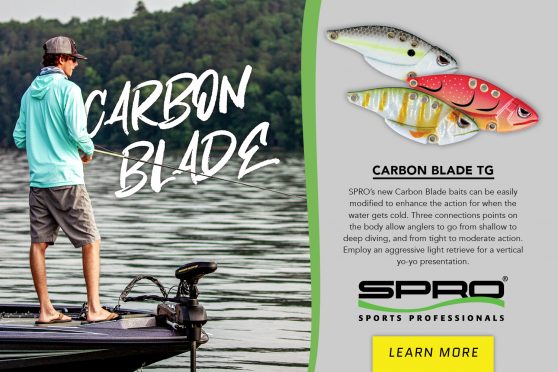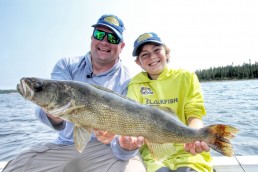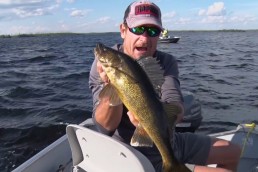Bottom Bouncer Basics for Walleyes
SHARE THIS POST
 In both North and South Dakota, bottom bouncer rigs have been catching walleyes on the Missouri River reservoirs for an awfully long time. The popularity of bottom bouncers, however, has expanded far and wide. Come midsummer, bottom bouncers are probably my go-to presentation to catch walleyes day-in and day-out on many different fisheries.
In both North and South Dakota, bottom bouncer rigs have been catching walleyes on the Missouri River reservoirs for an awfully long time. The popularity of bottom bouncers, however, has expanded far and wide. Come midsummer, bottom bouncers are probably my go-to presentation to catch walleyes day-in and day-out on many different fisheries.
The reason bottom bouncers are so effective is their simple versatility. You can speed up to cover water at over two miles per hour with a bottom bouncer. You can also slow down at a mile per hour or less. Fish deep water or shallow. Run plain snells and live bait. Run half-‘crawler, Slow Death style hooks that have become so popular over the last decade. You can run spinner harnesses with blades.
All these options enable the angler to fish slow or fast, with subtleness or vibration with flash. You can fish shallow or deep. Through this entire spectrum, bottom bouncers are forgiving in that you can slide out into deeper water or move up shallow and keep your presentation near the bottom. You can also simply put the rod in the rod holder and the rod will. load up when a fish strikes.
Bottom Bouncers
Bottom bouncers are so simple to use and so effective. I have often joked that bottom bouncers are a guide’s best friend because you can catch a lot of walleyes with a bottom bouncer regardless of experience or feel. Last, bottom bouncers are simply fun. Feeling a hard strike on a bottom bouncer and setting the hook is right up there with catching a fish on a jig.
Bottom bouncers can also help you really learn what you are fishing. The wire on a bottom bouncer transmits so much valuable information. They’re great tools for really fine-tuning bottom transitions and feeling rock, gravel, etc., which ultimately greatly aids your boat control and understanding of a location.
As a rule of thumb, we recommend an ounce of weight for every ten feet of water. Choosing the right weight is important, so that you can keep the bottom bouncer along the bottom upright and close to the boat. There are exceptions, of course; there are times when we will run lighter bottom bouncers behind the boat at faster speeds, particularly along shallow flats.
But this is the basic starting point: An ounce for every ten feet of water will enable you to easily fish the bottom bouncer below the boat at about a forty-five-degree angle behind the boat. This keeps your presentation close to what you are seeing on your electronics. As you change depths, you can always let out more line or pick up line. Usually, if there is any doubt, err on the side of heavy, because heavier bottom bouncers are much more forgiving with not only with depth but speed. Often, we simply catch more fish with bottom bouncers by simply speeding up to cover water to find active fish, triggering fish in the process.
Since I do like to run bottom bouncers at faster speeds, I am also a big believer in using heavier snells. This is not a case for finesse. If I must fish slow with light line, I often prefer to slip bobber or live bait rig. Heavier snells hold up to faster speeds so much better.
Heavier the Better
If your snell or harness is getting twisted, you are using too light of poundage on your snell. I find that 14- or even 20-pound-test snells track behind the bottom bouncer much better at the faster speeds and enable you to use speed to find and trigger fish.
Snell length can really vary. Most spinners are tied with a 5- to 6-foot snell, but I often prefer to use a shorter 3-foot snell when fishing around weeds or using Slow Death style hooks. Of course, there are exceptions. Long, 8- to 12-foot snells can be deadly in clear water or over a real soft bottom. When dealing with clear water or high numbers of incidental pike, I often tie snells with fluorocarbon and offset the sinking characteristics of fluorocarbon by using a float in the snell or spinner harness.
Perhaps one of the hottest trends we are seeing in our travels is the popularity of subtle harnesses that include small metal props, mylar blades like Mack Blades or plastic props like Northland Fishing Tackle Butterfly and Wingnut Blades. These blade options are more subtle than a traditional metal spinner blade and turn at much slower speeds, which is deadly whenever you must turn the boat a lot to stay on structure.
Are you enjoying this post?
You can be among the first to get the latest info on where to go, what to use and how to use it!
In clear water, using a simple plain snell is extremely deadly and is underrated at times. From the basic simple snell that has a single hook, you can experiment by adding a single bead or a handful of beads and a float. The next step with vibration is the prop options described above, and of course, classic spinner harness rigs are solid options when more vibration and flash is needed. I personally like to lean heavily on spinner harnesses whenever the water is dirty or stained either from wind, water color or algae blooms.
Spinner harnesses can also shine when the fish are extremely aggressive, as a turning blade can be seen and felt from much further away. On most inland lakes, deep-cup Colorado blades have long been the most popular choices and offer the most thump or vibration at the slowest speeds. Indiana blades shine at slightly faster speeds of over a mile and a half per hour, and willow leaf blades shine over open water and fast speeds, but they also put off noticeably less vibration.
Speed
As water temperatures climb through the summer, speed is your biggest trigger, especially when using bottom bouncers and snells. If we are missing fish, we often find that we improve our batting average by simply speeding up. There is often no need to drop the rod back or feed line; simply drag the fish and let them choke up on the bait. When the water temperatures are over seventy degrees, we often see the fish grab on to the bait, and as the bait keeps moving, the fish simply do not want the bait to get out of their mouths. When the rod loads from a fish, simply drag the fish until the rod starts to load even more, and as you feel the fish shake, set the hook with a sweep of the rod, or use the momentum of the boat to hook the fish. This is why a rod holder will often out-fish you holding the rod when you are using bottom bouncers.
Bottom bouncers and spinner harnesses can be run with no live bait as well, which can be extremely deadly at times. Gulp ‘crawlers and minnows or traditional soft plastic fluke and worm profiles are much more durable than live bait and really shine around weeds or small nuisance fish. I often find that I can catch bigger walleyes by ditching the live bait options and using soft plastics. One of my favorite tricks for improving the size of walleyes I catch with harnesses is using soft plastic or Gul! behind a harness and hooking the soft bait with a two-hook harness so the bait is warped or curved like a banana. These curved soft baits zig zag and swim through the water at over a mile and a half per hour and really seem to trigger the larger fish. And the added movement seems to keep the smaller fish from being able to get their mouths around the bait.
Tackle
For rods and reels, I prefer to use a baitcasting set up. I personally like to use a stiffer seven-foot medium-heavy bait casting rod, as the stiffer rod loads up and pops the bottom bouncer through rocks and snags much better, especially if you have the rods in the rod holders. Stiffer rods are also needed to hook up fish at slower speeds below the boat. Scheels currently has a perfect bottom bouncer rod in their Walleye Series that is a seven-foot casting rod in a medium-heavy action. For holding the rod, nothing beats a good baitcasting reel with a flipping switch, which is getting harder to find. Quantum still makes a reel with a flipping switch called the Accurist PT. For running bottom bouncers in rod holders or when guiding, Scheels has an exclusive low-profile line counter reel that is incredible for keeping bottom bouncing simple and easy.
Bottom bouncer rigs are so incredibly effective on so many fisheries right now. In fact, if I could only use one presentation alone during the month of July, it would be hard to beat a bottom bouncer teamed up with either a spinner harness or some type of rig. You can slow down a bottom bouncer and fish a plain snell dressed with live bait; for example, if the bite gets tough after a front, or in the middle of the day when there is no wind. You can trigger fish with speed and harnesses or go with more subtle hybrid rigs like Butterfly Blades and cover a lot of water on the other end of the spectrum.
Bottom bouncers shine around rock, gravel and sand. Bottom bouncers are one of my favorite presentations for running weed line edges, as the bottom bouncer serves as a large weed guard, collecting a lot of the weeds while the harness runs clean behind. There are few tools that will help you catch more walleyes right now under so many different conditions.
Become a MidWest Outdoors Insider here!
MWO
SHARE THIS POST
Did you enjoy this post?
You can be among the first to get the latest info on where to go, what to use and how to use it!
Jason Mitchell
Jason Mitchell was a top walleye guide on Devils Lake, N.D. for nearly 20 years. Today, Mitchell produces the Jason Mitchell Outdoors TV program. Visit jasonmitchelloutdoors.com for more.



